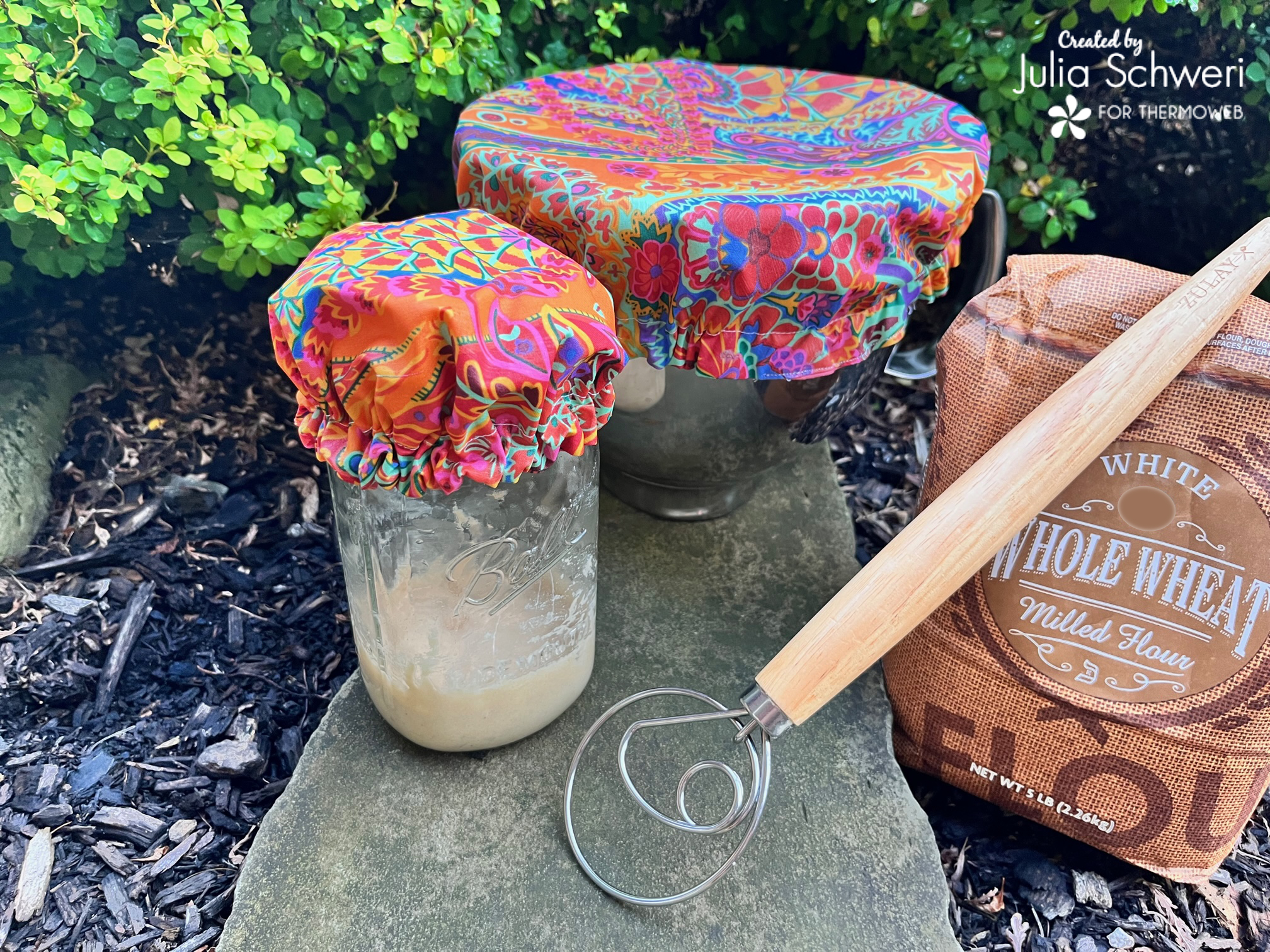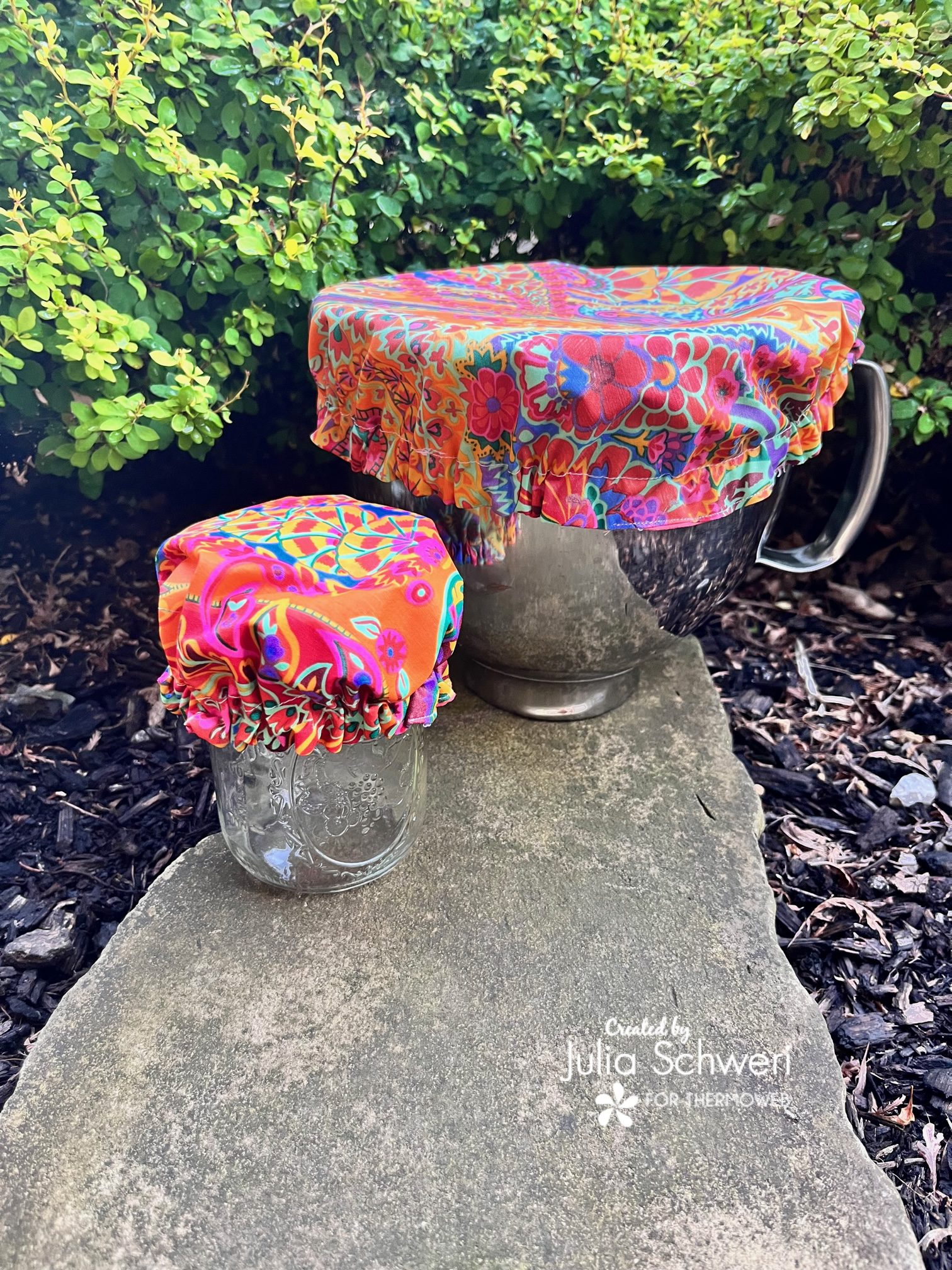Hello and welcome!
It’s Julia from Inflorescence Designs! I’m so joyful you are visiting today. For today’s tutorial, I am going to show you how to make bowl and jar covers using Thermoweb’s Liquid Vinyl!
I love to bake bread and I greatly dislike when a recipe calls for you to cover your dough in plastic wrap. I understand that the plastic creates a moisture barrier and will keep your dough from getting a skin on top. However, I do not like the waste.
I have created a tutorial for you sharing how you can create your own bowl and jar covers that mimics the use of plastic wrap. This tutorial is really simple, and you can create ANY size cover you need. I even made a “decorative” cover for my sourdough starter, so she can look pretty since she sits on my counter.

Liquid Vinyl can make your favorite fabrics stain-resistant, water-resistant and even waterproof. Simply paint on a thin layer, let dry and then iron to create a smooth, protective finish. You can create different effects, including a semi-gloss oilcloth look, by applying multiple layers of Liquid Vinyl. My favorite part is you are not limited to commercially available laminated fabrics.
Bowl & Jar Covers using Liquid Vinyl
Supplies:
- HeatnBond Liquid Vinyl
- Thermoweb’s Pressing Paper
- Coordinating Fabric for front and back
- 3/8″ elastic (length may vary depending on project size)
- Safety Pin
- Soft Bristle or Foam Brush
- Basic Sewing Notions
- Oliso Iron
- Something to paint on. I usually use file folders or an old cutting board
- Ofla Cutting Mat
- Pinking Shears

Instructions:
Begin by…
Find out the size of the bowl or jar you want to make a cover for. I used my KitchenAid Mixing bowl and it measured just under 9″. My wide mouth canning jar measured just over 3″.

Next…
Grab your fabric and place your bowl on top. Measure out 3″ from the bowl all the way around mark that with a marking tool. Cut out your circles. My larger bowl ended up being 15″ in diameter and my small jar circle was 9″.
Important Tip: I like to layer my front and back fabric together so when cutting they are identical. You can also use a circle cutting tool if your circle falls within the measurement range of the tool you are using. I used a circle tool for my jar cover and I just rounded to the nearest whole number.

Continue by…
Now it is time to add the liquid vinyl. Liquid vinyl is non-toxic but has not been tested for food safety. Because of this, we are only adding the liquid vinyl to the outer top fabric. The lining will not have liquid vinyl which will protect your bread dough if it happens to rise and touch your bowl cover.
Important Tip: Liquid Vinyl is machine washable after it has cured 24 hours. Wash on the cold setting and air dry.

For this project, I used ONE coat of Liquid Vinyl. The number of coats is a personal choice for this project.
General Directions
Works best on smooth fabrics. Pre-wash and dry all materials without fabric softener. Please note, the application of HeatnBond Liquid Vinyl may slightly alter the fabric’s original appearance. For best results, always pre-test before starting the project.
Protect the workspace with a non-stick surface such as HeatnBond Pressing Paper, parchment paper or a silicone craft mat.
- Paint on a thin layer of Liquid Vinyl using a soft-bristled paintbrush or foam brush; rinse the brush and wipe off the rim of the jar before recapping.
- Let fabric dry 30-45 minutes.
- Preheat the iron to medium heat, with no steam.
- Place fabric on top of parchment paper or a non-stick pressing sheet on a firm, heat-proof surface (not an ironing board) and cover with HeatnBond Pressing Paper. Press for 45 seconds, moving the iron slightly. For larger pieces, slightly overlap areas until the entire surface has been pressed.
- Repeat Steps 1-4 to apply additional coats of Liquid Vinyl, pressing after each coat.
Next…
Once the fabric for the top of your food cover has the Liquid Vinyl applied and pressed, it is time to sew it. Place your circles right sides together and sew around the perimeter 3/8″ leaving a 2 inch opening for turning.


Next…
Trim with pinking shears but leave the unsewn area as is. I like to have extra fabric there for turning under. Once the seam is trimmed, turn your bowl cover right side out and press, turning the opening fabric under. Make sure to use pressing paper when ironing over the Liquid Vinyl covered fabric.

Continue by…
You will need to make a casing for the elastic. Sew 3/4″ away from the edge of the bowl cover.
Important Tip: I suggest having the lining on top and the fabric with the Liquid Vinyl on the bottom when sewing. The fabric with the Liquid Vinyl can sometimes stick to your presser foot but it goes over the feed dogs just fine. If you have a non-stick foot you can use that as well.
Then…
Grab the safety pin and elastic. Attach the safety pin to the elastic and thread the elastic into the casing through the opening. Pull the elastic tight. Place your bowl cover over the bowl to measure how tight you want the elastic. Mark the elastic with a pin or pencil. Then, sew with a zigzag stitch.

Finally…
Using a 1/8″ seam, close the opening of the bowl cover.
Need more visual help? Check out the YouTube Video Tutorial HERE!
Finished!

Thank you for visiting today! Come back soon to see what else will be starting to bloom with Inflorescence Designs!
Starting to bloom by choosing JOY ~ Julia
